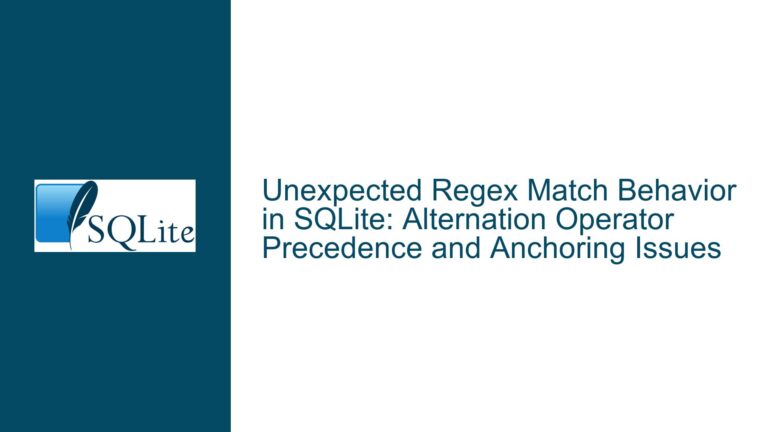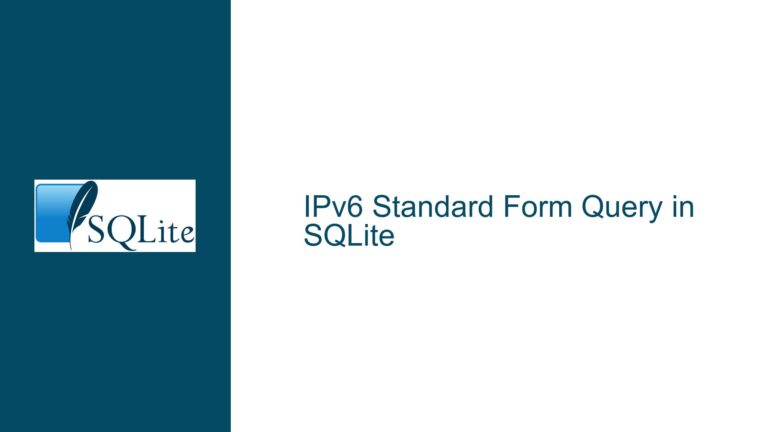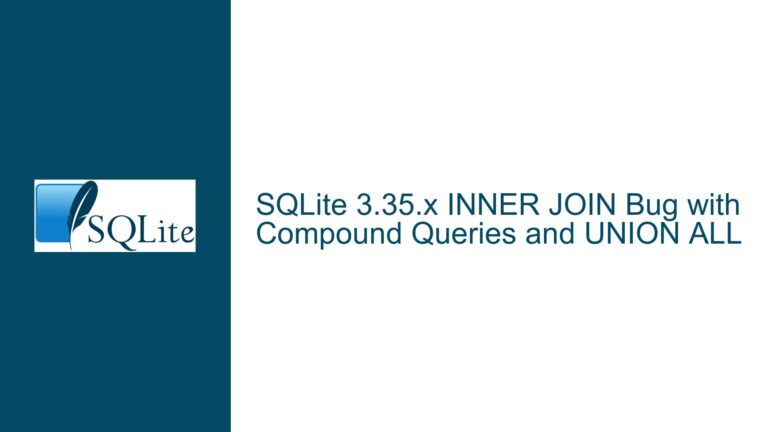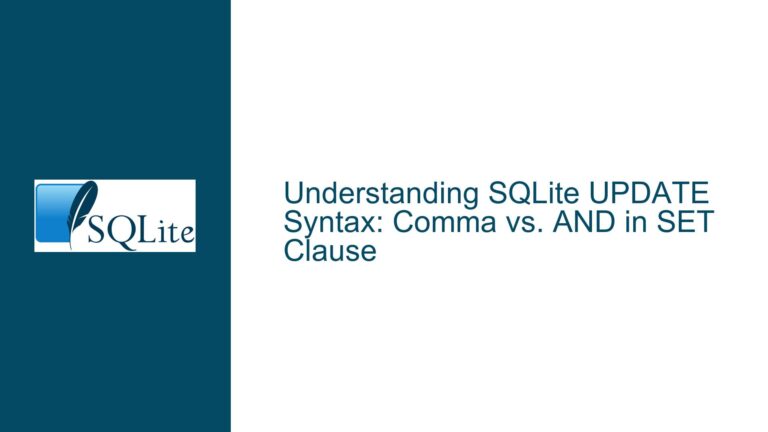SQLite hex() Function Behavior and Correct Decimal to Hexadecimal Conversion
Issue Overview: Discrepancy Between hex() Function Output and Expected Hexadecimal Conversion
The core issue arises when attempting to convert an integer value to its hexadecimal representation using SQLite’s hex() function. Users expect the function to return the hexadecimal equivalent of the integer, similar to online decimal-to-hexadecimal converters. However, the hex() function produces a different result. For example, when converting the integer 101056520, hex(101056520) returns 313031303536353230, whereas online tools return 6060008. This discrepancy stems from a fundamental misunderstanding of how the hex() function processes its input.
The hex() function in SQLite is designed to convert BLOB values (binary large objects) into a hexadecimal string representation. When a numeric value (integer or floating-point) is passed to hex(), SQLite first converts that number into its UTF-8 text representation, treats the resulting string as a BLOB, and then converts each byte of that BLOB to its two-digit hexadecimal equivalent. For example, the integer 101056520 is first converted to the string '101056520'. Each character in this string is then converted to its ASCII code point (e.g., '1' becomes 0x31, '0' becomes 0x30), resulting in the hexadecimal string 313031303536353230.
This behavior contrasts with the expectation that hex() would directly convert the integer’s binary representation (i.e., its bytes in memory) to hexadecimal. For instance, the integer 101056520 in 64-bit binary form is 0x00000000060C0C08, which would be rendered as 060C0C08 (with leading zeros omitted in some contexts). However, SQLite does not handle numeric values this way in the hex() function. The confusion arises from conflating two distinct operations:
- Converting a numeric value to its hexadecimal string representation via ASCII encoding.
- Converting the binary bytes of a numeric value to hexadecimal.
The root cause lies in SQLite’s type handling and the design of the hex() function, which prioritizes BLOB and text processing over numeric base conversion.
Possible Causes: Misapplication of hex() Function and SQLite Type Conversion Rules
1. Misunderstanding the Purpose of hex()
The hex() function is explicitly documented as a BLOB-to-hexadecimal converter. When applied to non-BLOB inputs, SQLite implicitly converts the input to a BLOB via its text representation. This is a deliberate design choice, not a bug. For example:
hex(123)converts the integer123to the string'123', then to the BLOBx'313233', resulting in313233.hex('abc')converts the string'abc'to the BLOBx'616263', resulting in616263.
Users expecting hex() to act as a numeric base converter are applying the function outside its intended scope.
2. Implicit Type Conversion in SQLite
SQLite uses dynamic typing, meaning values are not rigidly bound to a specific data type. When a numeric value is passed to a function expecting a BLOB or string, SQLite automatically converts the number to a text representation. This conversion follows standard UTF-8 encoding rules. For instance:
- The integer
101056520becomes the string'101056520'. - The floating-point value
123.45becomes the string'123.45'.
The hex() function then processes this string as a BLOB, converting each byte to hexadecimal. This leads to the unexpected result when numeric values are involved.
3. Lack of Built-in Numeric Base Conversion Functions
SQLite does not natively provide functions for converting integers between decimal and hexadecimal bases. While other databases or programming languages might include to_hex() or format() with base conversion specifiers, SQLite’s printf() function (via the %x format specifier) is the closest equivalent. Users unaware of this workaround may resort to incorrect methods like hex().
4. Ambiguity in Numeric Representations
Hexadecimal conversions can refer to two distinct operations:
- Numeric Value to Hexadecimal String: Converting the mathematical value of a number (e.g.,
255becomesFF). - Binary Data to Hexadecimal String: Converting the raw bytes of a value (e.g., the 4-byte integer
255in little-endian format isFF000000).
The hex() function performs the latter when given a BLOB, but the former is often what users require. This ambiguity leads to confusion.
Troubleshooting Steps, Solutions & Fixes: Correctly Converting Integers to Hexadecimal in SQLite
1. Using printf() for Numeric Base Conversion
The printf() function in SQLite supports format specifiers for hexadecimal conversion:
%x: Lowercase hexadecimal (e.g.,printf("%x", 255)→ff).%X: Uppercase hexadecimal (e.g.,printf("%X", 255)→FF).
Example:
SELECT printf("%x", 101056520); -- Returns '6060008'
SELECT printf("%X", 101056520); -- Returns '6060008' (uppercase not applicable here)
Limitations:
printf()does not support specifying the output width (e.g., padding with zeros).- Large integers may lose precision if they exceed SQLite’s 64-bit integer storage.
2. Handling Negative Numbers
The printf("%x") specifier handles negative integers by converting their two’s complement representation:
SELECT printf("%x", -42); -- Returns 'ffffffffffffffd6' (64-bit two's complement)
To emulate unsigned behavior, cast the number to a BLOB and use hex():
SELECT hex(cast(-42 as BLOB)); -- Returns 'D6FFFFFFFFFFFFFF' (little-endian)
Note that this requires understanding endianness and byte order.
3. Custom Hexadecimal Conversion via User-Defined Functions
For advanced use cases, create a user-defined function (UDF) in a host language (e.g., Python, C) to perform precise base conversions. Example in Python using sqlite3:
import sqlite3
def decimal_to_hex(num):
return format(int(num), 'x')
conn = sqlite3.connect(':memory:')
conn.create_function("to_hex", 1, decimal_to_hex)
cursor = conn.cursor()
cursor.execute("SELECT to_hex(101056520)").fetchone() # Returns ('6060008',)
4. Hexadecimal Conversion via Arithmetic Operations
For environments where UDFs are unavailable, use arithmetic to manually convert integers to hexadecimal:
WITH RECURSIVE hex_chars(n, val, result) AS (
SELECT 0, 101056520, ''
UNION ALL
SELECT
n + 1,
val / 16,
substr('0123456789abcdef', (val % 16) + 1, 1) || result
FROM hex_chars
WHERE val > 0
)
SELECT coalesce(max(result), '0') FROM hex_chars;
This recursive CTE repeatedly divides the number by 16, appending the remainder as a hex digit.
5. Avoiding hex() for Numeric Conversions
Educate users that hex() is unsuitable for numeric base conversion. Reserve its use for BLOBs:
-- Correct use of hex() with a BLOB
SELECT hex(cast(101056520 as BLOB)); -- Returns '393031303536353230' (text '901056520' in hex)
Note that casting an integer to a BLOB directly (e.g., cast(101056520 as BLOB)) may still not yield the desired result due to encoding differences.
6. Cross-Validating with External Tools
When discrepancies arise, cross-validate SQLite’s output with trusted tools:
- Use online converters to verify expected hexadecimal values.
- Compare SQLite’s
printf("%x")output with programming language results (e.g., Pythonhex(101056520)).
7. Understanding Endianness and Byte Representation
For applications requiring precise byte-level hexadecimal output (e.g., network protocols), use BLOBs with explicit endianness:
-- Convert integer to little-endian BLOB and then to hex
SELECT hex(cast(101056520 as BLOB)); -- Depends on SQLite's internal representation
Note that SQLite does not provide built-in functions for endianness control, necessitating external preprocessing.
8. Documentation and Community Resources
Direct users to SQLite’s official documentation for hex() and printf():
Emphasize the importance of reading function specifications to avoid misuse.
This guide systematically addresses the root causes of the hexadecimal conversion discrepancy in SQLite, provides actionable solutions, and clarifies the nuances of SQLite’s type handling. By leveraging printf(), UDFs, or manual arithmetic, users can achieve accurate numeric-to-hexadecimal conversions while avoiding pitfalls associated with the hex() function.






